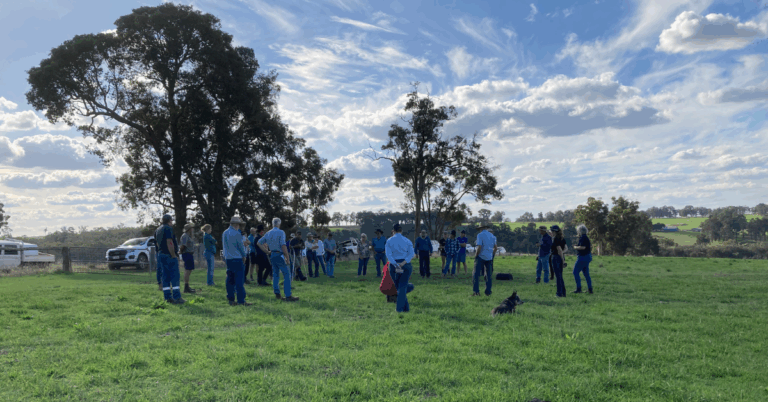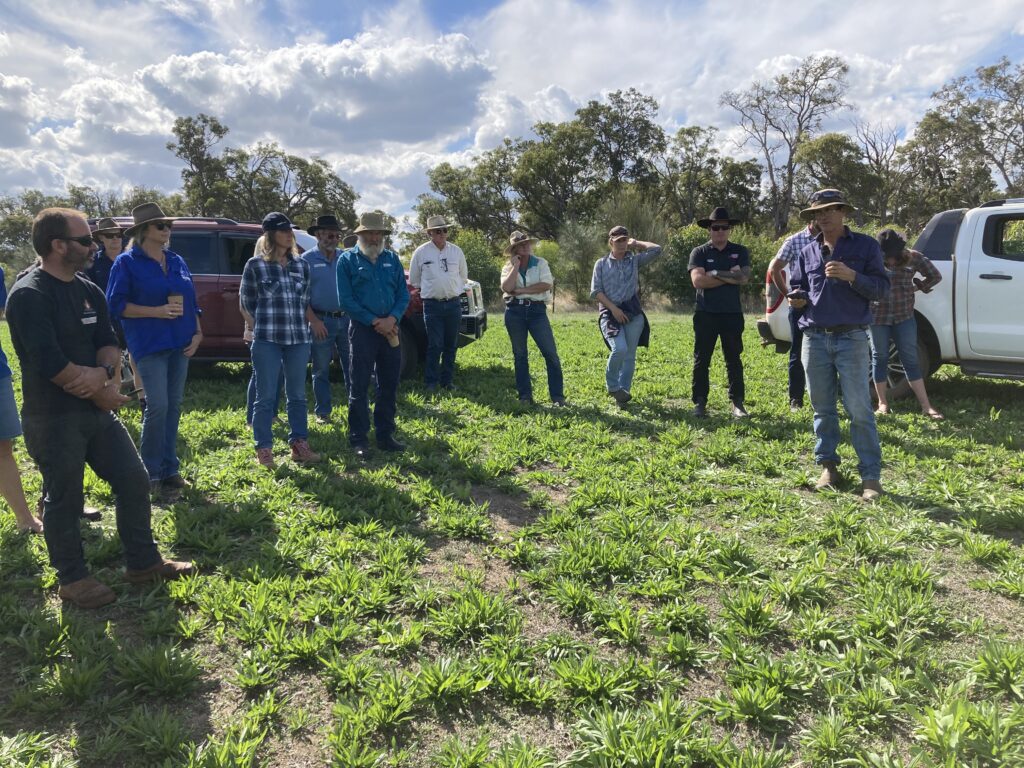
There’s not many farmers in South West WA with more perennial pasture experience than Warren Pensini. Warren started incorporating perennial pastures into his Boyup Brook farm 15 years ago.
And thankfully, Warren is always eager to share what he has learned with others. Warren and his agronomist Col Bowey passed on their experiences with perennials to a crowd of 40 at Warren’s farm in April 2025.
The event, delivered by Western Beef Association under South West NRM’s FEAST2030 project, aimed to find out what species have been beneficial, and what is required to establish perennials in South West WA.
“We sell a grass-fed beef product, but we also supplement with hay and a lupin-based pellet, Warren said.
“We want to extend our growing season so our cows are on grass for longer, which is also cheaper. That’s where perennials are really important to us.”
Warren’s Tips
Warren’s first tip at the event was to consider using phalaris – a grass that has developed significantly in recent years.
“It used to be that you could only plant phalaris in the wet areas and in the heavier type soils,” he said.
“We’ve got phalaris growing on top of our gravelly ridges now, partly due to better varieties. The big issue with phalaris was the staggers, but the newer varieties are a lot safer.
“It’s my number one go to, the first thing I put in the mix, because it grows on the spit of a rain. Last year, when we came through that horrible dry summer in March we had it shooting on dew.”
Col thinks some varieties of phalaris are well suited to the high iron and aluminium soils, and these constraints influence what varieties are suitable. Warren agrees.
“We can’t just grow what works over east,” he said.
“We need to find varieties that work here. We’re using a lot of calcium (gyp-lime and calcium foliar) to buffer that aluminium and iron out to get the roots to punch through and find the moisture”.
Other species Warren has used are cocksfoot, fescue, chicory, plantain and lucerne.
“Cocksfoot, we’ve had mixed results with. There’s a particular variety that we have been able to grow – – Drover, but we can’t get anyone to bring it into WA.
“I’ll try Uplands this year. Stockmans is probably another decent variety.
“Fescue is another one that’s been a bit tricky, I’ve got one paddock of fescue that I planted 15 years ago. Unfortunately it’s an older variety that’s not particularly palatable, but it’s a good base.
“I probably wouldn’t plant that variety again and most of the newer varieties haven’t gone that well but I’ll have another crack at another variety this year.
“Lucerne, I have a love hate relationship with. I love it, the cattle love it, but so do the bugs!”
Warren has had some success sowing lucerne, chicory and plantain by themselves and using a grass-selective herbicide to control annual ryegrass. Then he can sow perennial grasses over the forbes the following year.
“I was just staggered at the difference it made to the survival rate of the forbes. And the lucerne, chicory and plantain seemed to grow well together,” he said.

Col agrees:
“Getting those perennial forbes in first also helps the perennial grasses later by giving them a pathway,” he said.
“Chicory is a good one because, you might not have rain, but as soon as the humid nights come in, it just sucks the moisture out of the air and takes off.”
Warren hasn’t tried sub-tropicals, and Col suggests using winter actives in what is very much a winter rainfall area, rather than trying to grow something in the middle of summer.
“The winter actives will store their energy for our growing season. We lack relative humidity between Christmas and the middle of February (making it very hard to grow),” Warren said.
“Generally in most places in the world there’s 8-10 months of the year where you grow the most production, and there’s a two-month rest period.”
Clovers aren’t a big focus in Warren’s seeding program, but both he and Col think perennials help the sub clover that emerges from the seedbank.
“I think the subs just get better with the perennials. We had a patch last year of Phalaris with sub clover growing through it and it was just the most magnificent bit of pasture,” Warren said.
Perennial Challenges
As alluded to earlier, one of the biggest challenges to perennial pasture establishment is weeds and particularly annual pastures like ryegrass. It’s a lesson Warren has learned the hard way.
“Back in the day I’ve direct drilled perennials at this time of the year (April) and wondered why they didn’t grow,” he said.
“And there was a few reasons but they just do not compete with annuals, particularly grasses.
“We’ve established them in an organic situation where we were ploughing, and it was ok but not as good as now. A double knock is a minimum, even in the year before sowing.
“So the paddock we’re sowing this year we cut hay off that for two years we then sprayed it out last year and planted sorghum. Hopefully we’ve nailed a lot of the grass.
“We’ll still do another double knock (two knock-down sprays) on that paddock before we seed them.”
The other critical aspect is grazing management. Warren says that if you’re going to set-stock, you may as well forget about it. That’s particularly vital in the first year.
“If you get one graze out of it in the first year you’re doing well. We usually do pretty well out of the chicory and plantain,” he said.
“Last year we got three or four grazes off it. But they’re a bit different, you can go a bit harder on those.
“But once your grasses are established, like the phalaris we have, I actually did set stock it for nearly a month, so once it’s established you can flog it if you have to. It’s not the best for production but it won’t kill it.
“Generally speaking, we have a minimum 40-day recovery after grazing through the growing season. With these newer species of chicory and plantain we will try and leave at least a third (of each plant) behind each graze,” he said.
“They act a bit differently to the grasses. We can get a quicker rotation out of them.
“Short graze time is also important. You don’t really want to be grazing longer than three days because any longer than that and the animals are coming back for the second and third bite.”
Event Feedback
There are significant challenges to establishing perennial pastures in South West WA, and the event didn’t shy away from them.
Nevertheless, post-event feedback suggested attendees went away with a lot more knowledge and confidence that, managed well, it was possible to establish perennials in the region.
Waren is one of ten producers trialling perennial pastures in the South West under South West NRM’s FEAST2030 project. You can stay informed by subscribing to our newsletter for updates.

The FEAST 2030 project is supported by the Australian Government through funding from the Natural Heritage Trust under the Climate-Smart Agriculture Program and delivered by South West NRM, a member of the Commonwealth Regional Delivery Partners panel.
